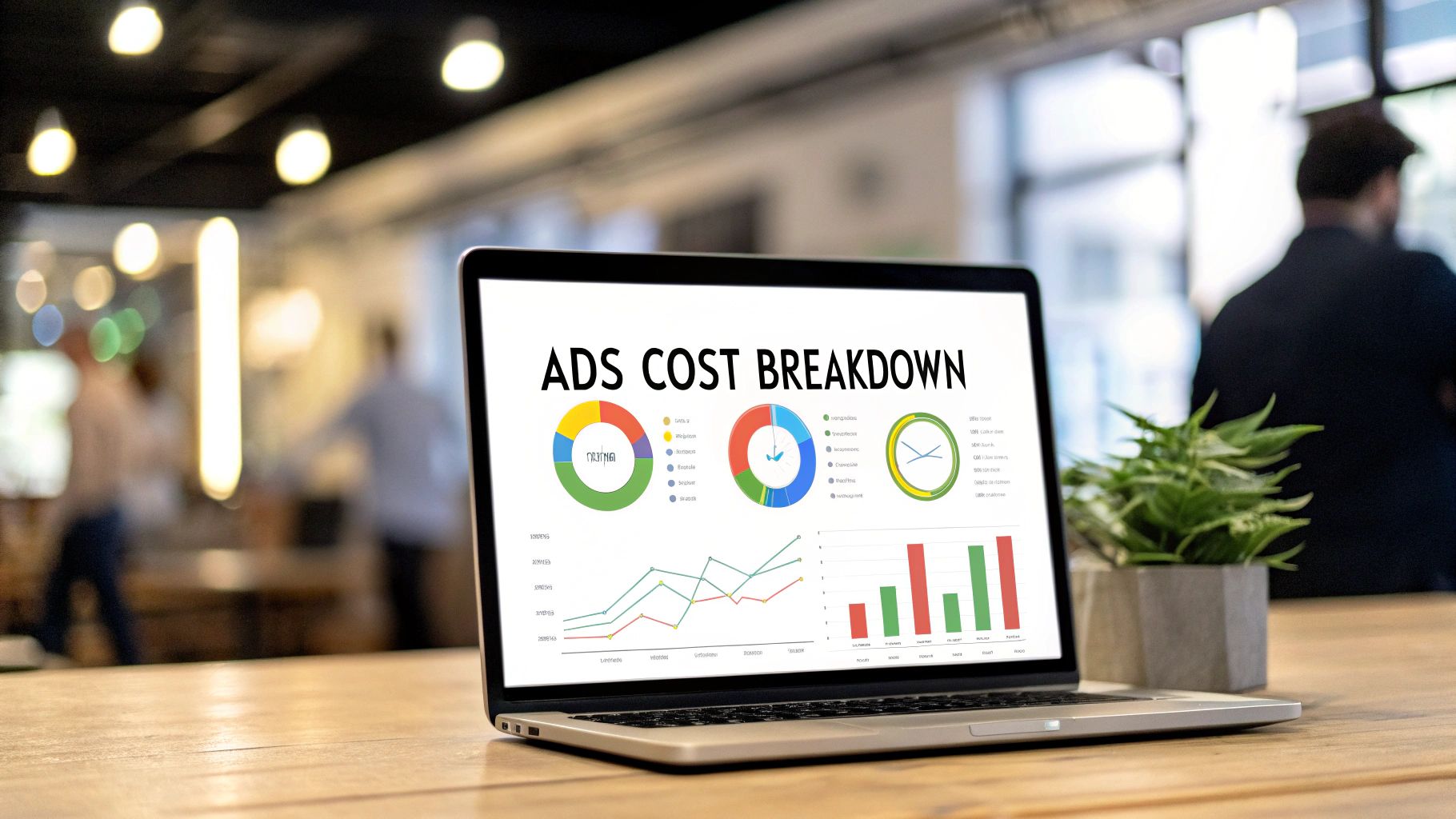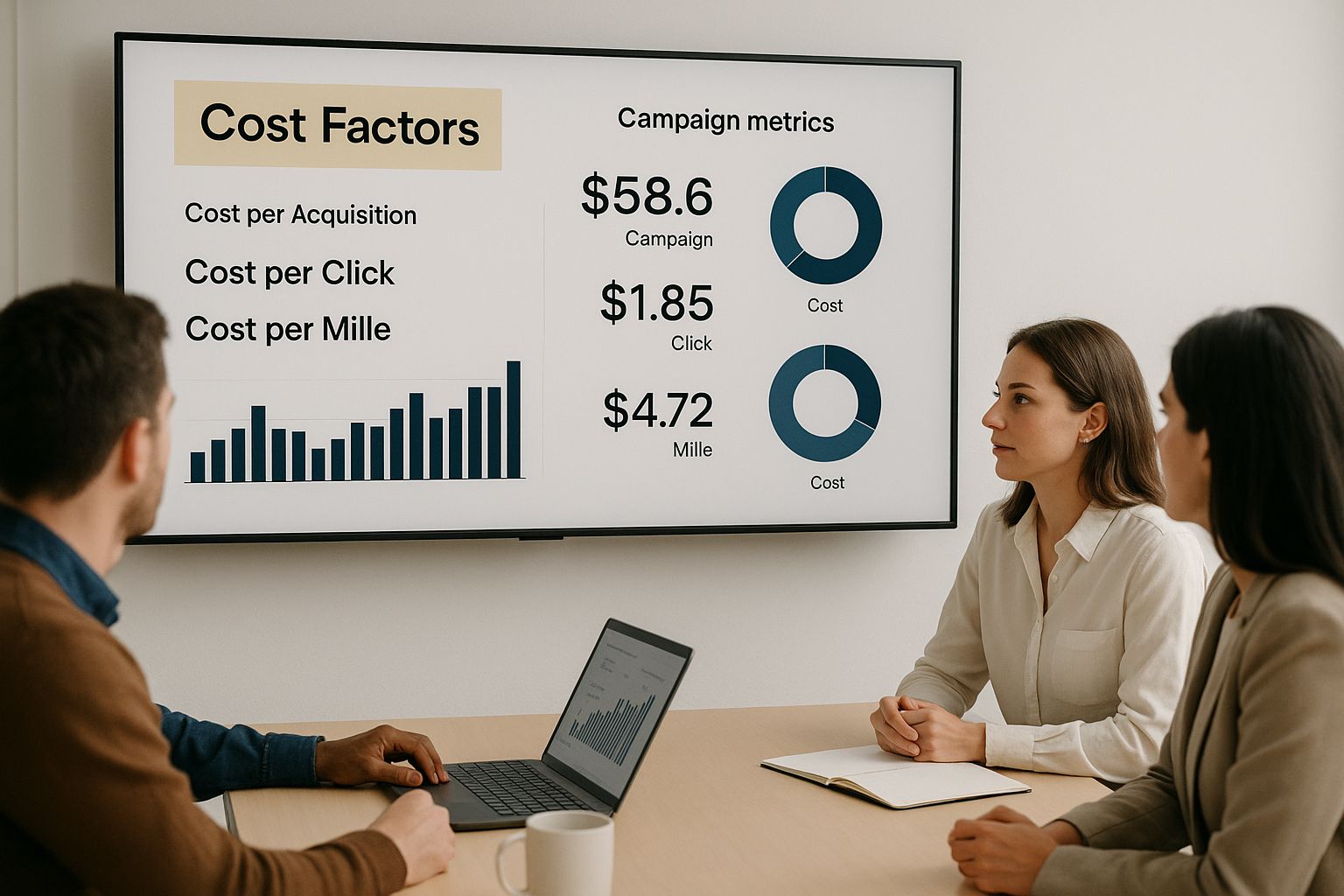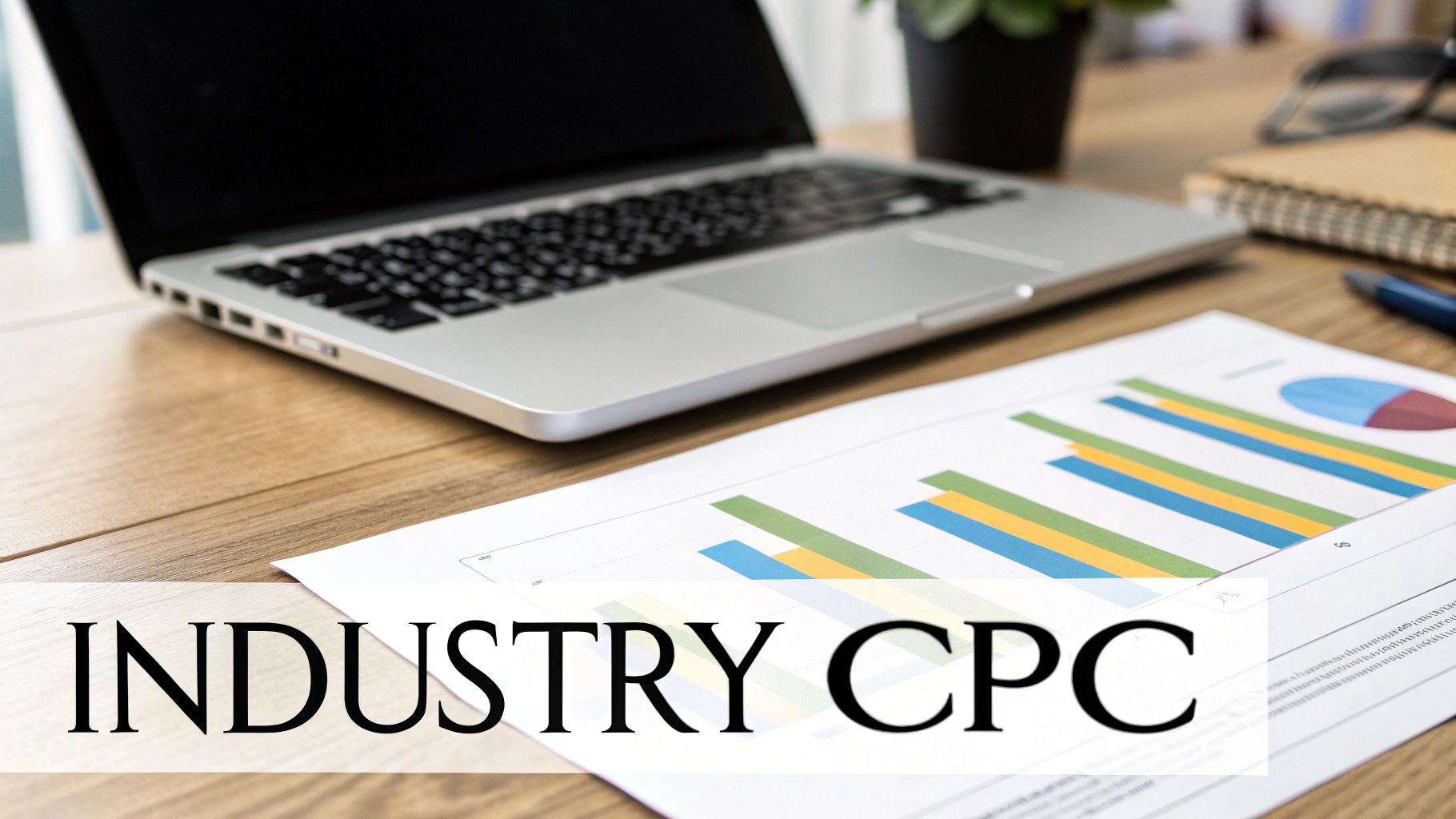October 7, 2025
How Much Is Google Ads? A Realistic Cost Breakdown


Alright, let's talk numbers. The big question on everyone's mind is: how much is Google Ads actually going to cost me?
The honest, no-fluff answer is... it depends. There isn't a simple price tag. Most small to medium-sized businesses typically spend somewhere between $1,000 and $10,000 per month, but that's a huge range. Your final bill really boils down to your industry, your specific goals, and how effectively you're running your campaigns.
A Realistic Look at Google Ads Costs
Trying to pin down a single price for Google Ads is a bit like asking "how much does a car cost?" Are we talking about a used sedan or a brand-new luxury SUV? The same logic applies here. Your final ad spend is a direct result of how competitive your industry is, the keywords you're targeting, and even the geographic location of your customers.
To set a budget that actually makes sense, you have to get comfortable with the numbers that drive your costs. While there's no magic number that fits every business, looking at key averages can give you a much clearer financial picture. It's about shifting from guesswork to making a smart, informed investment.
Google Ads Costs At a Glance
Here’s a quick summary of the average costs you can expect. Think of this as a starting point to help set your expectations.
These numbers provide a general idea, but remember, your own costs will be unique to your business and market.
Key Cost Benchmarks
Let's break those numbers down a bit more. Here are the figures you should really have on your radar:
Average Cost-Per-Click (CPC): This is the classic metric—what you pay every single time someone clicks on your ad. Across the globe, the average CPC for a search ad is about $2.69. But in a super competitive market like the United States, that average jumps to $6.56. That higher cost reflects just how many businesses are vying for those top ad spots. You can dig into more of these advertising stats over at Analyzify.com.
Typical SMB Monthly Spend: As we mentioned, the sweet spot for most small and medium-sized businesses is between $1,000 and $10,000 a month. In fact, SMBs make up about 65% of all Google Ads advertisers. Starting on the lower end of that range is a smart move—it lets you test the waters and gather real data before you start pouring more money in.
Remember, the goal isn't just to find the cheapest clicks. It's about finding the most profitable ones. A higher CPC might seem intimidating, but if it brings in a customer who spends a lot of money with you, it's a fantastic return on investment.
Getting a handle on these benchmarks is your first step. If you want a more personalized estimate that's dialed into your specific industry and goals, check out our handy Google Ads cost calculator to get a better sense of what you might spend.
How The Google Ads Auction Really Works
Ever wondered why one click costs what it does? It’s not some random number Google pulls out of thin air. Every single time someone searches for something, a lightning-fast auction takes place behind the scenes to decide which ads show up and in what order.
But don't think of it like a traditional auction where the highest bidder automatically wins. It’s more like a talent show. Your bid matters, sure, but so does the quality of your act—your ad. It’s entirely possible for an advertiser with a lower bid to snag a better ad spot simply because their ad is more relevant and helpful to the searcher.
Ad Rank: Your Ticket To The Top
The winner of this split-second auction is determined by something called Ad Rank. It’s a score Google calculates for every ad competing for a spot, and it's pretty simple: the ad with the highest Ad Rank gets the best position.
So what goes into your Ad Rank? It's a mix of a few things, but the two big ones you need to know are:
- Your Maximum Bid: This is the absolute most you’re willing to spend for a single click on your ad.
- Your Quality Score: This is Google's grade, from 1 to 10, on how relevant and high-quality your ads, keywords, and landing pages are.
The formula is as straightforward as it gets: Ad Rank = Your Maximum Bid x Your Quality Score. This simple math shows why a killer Quality Score can let you outrank competitors who are actually bidding more than you.
This infographic does a great job of breaking down the main cost factors you should be keeping an eye on.

As you can see, your bid, the quality of your ad, and the level of competition all mix together to determine what you ultimately pay for a click.
Why Quality Score Is Your Secret Weapon
Okay, so how much do you actually pay? Here’s the crazy part: you almost never pay your full maximum bid. The real amount you pay per click (your CPC) is figured out by looking at the Ad Rank of the advertiser right below you, dividing it by your own Quality Score, and then just adding one cent.
This is exactly why having a high Quality Score is such a massive advantage. It's not just a vanity metric; it directly lowers your costs. A competitor could have a bottomless budget, but if their ads are junk and their landing pages are slow, they'll be forced to overpay for every single click.
Meanwhile, by focusing on improving your ad relevance and giving users a great experience, you can win better ad positions for less money. It’s the ultimate way to play smarter, not just spend more.
The Key Factors That Control Your Ad Spend

So, what actually determines how much you spend on Google Ads? It’s not a simple price tag. Think of it more like a control panel with a bunch of different levers. If you know which ones to pull, you can get way more bang for your buck. But if you ignore them, your costs can quickly get out of hand.
The biggest lever, and the one you can’t really change, is just how competitive your industry is. It's a simple fact that some niches are just way more expensive than others.
For example, a keyword like "personal injury lawyer" can cost an absolute fortune per click. Why? Because landing a single client can be worth tens of thousands of dollars. On the other hand, a click for "handmade bookmarks" will be a whole lot cheaper. It’s basic supply and demand.
Competition and Industry Benchmarks
How much you'll pay and the results you'll see swing wildly from one industry to another. For instance, the Arts & Entertainment world sees a massive 13.10% average click-through rate (CTR), with Sports & Recreation not far behind at 9.19%.
These numbers show why you can't just copy a strategy from a different industry and expect it to work. The whole game is different depending on who you're up against. In the United States, the average cost-per-click (CPC) is around $6.56, but that's just an average.
Knowing your industry's benchmarks is your starting point. It helps you set a budget that's actually realistic and gives you a baseline for what a "good" CPC even looks like in your world.
Keyword Strategy and Intent
The keywords you choose to bid on are another huge piece of the puzzle. This is where you can get really strategic and save a ton of money.
Broad Match Keywords: Think of general terms like "shoes." They get a lot of searches, sure, but you also attract a lot of window shoppers who have no intention of buying. This can burn through your budget fast.
Long-Tail Keywords: Now think of something super specific, like "women's red running shoes size 8." The search volume is much lower, but the person typing that in knows exactly what they want. These clicks are almost always cheaper and convert way better.
Zeroing in on those long-tail keywords is one of the smartest moves you can make. You’re putting your ad in front of people who are already halfway to the checkout.
A well-structured keyword strategy doesn't just chase volume; it targets intent. By focusing on users who know what they want, you can dramatically improve your return on ad spend.
The Power of Quality Score
Finally, we get to the most important factor you have direct control over: your Quality Score. We touched on this before, but it's Google's grade on how relevant your keywords, ad copy, and landing page are to the person searching.
The better your Quality Score, the less you pay per click and the higher your ad shows up. It's literally Google giving you a discount for making its users happy.
A huge part of that user experience is what happens after they click your ad. A slow, clunky website is a great way to get a low Quality Score. That's why it's so important to learn how to improve website loading speed. A fast-loading, relevant landing page is a massive signal to Google that you’re a good match for the searcher, and they'll reward you for it with lower costs.
Average Google Ads Costs By Industry
So, we've covered the different levers you can pull to control your ad spend. But there’s one giant factor that you can’t really change: your industry. The simple truth is that not all clicks are created equal. The cost of a click can swing wildly depending on the market you’re in.
This is why a click for a personal injury lawyer might cost over $8, while a click for an indie movie blog could be less than $2. It all comes down to what a new customer is potentially worth. A single client for a law firm could mean tens of thousands in revenue, which makes a high Cost-Per-Click (CPC) a perfectly reasonable investment.
A Look at the Numbers
Knowing the going rate in your industry is essential. It helps you set a realistic budget and tells you whether you're overpaying or getting a great deal. After all, you wouldn't expect a small local bakery to have the same advertising budget as a nationwide insurance carrier, right?
The cost differences are often dramatic. Industries like legal services, dentistry, and home improvement consistently have some of the highest CPCs around. This is driven by fierce competition and the high lifetime value of each customer. On the other hand, sectors like travel or restaurants often have much lower click costs but need a lot more of them to make a profit.
Knowing the typical costs in your niche is a strategic advantage. It prevents you from panicking over a high CPC that's actually normal for your industry or, conversely, thinking you’re doing great when you’re actually paying above average.
To give you a clearer picture, let's look at some real numbers.
Average Cost Per Click (CPC) Across Different Industries
The table below breaks down the average costs and performance metrics for a handful of common industries. It really puts the cost variation into perspective.
This data makes it obvious just how much your industry dictates your costs. A real estate agent paying $2.53 per click is doing just fine, but a lawyer paying that same amount would be getting an unbelievable deal.
If you want to explore these numbers further, our guide on Google Ads industry benchmarks breaks it down in even more detail.
Think of these benchmarks as your starting line. They give you the context you need to build a smarter, more effective advertising strategy from day one.
Proven Strategies To Lower Your Ad Spend

Knowing the average cost of Google Ads is one thing, but figuring out how to actually lower that cost is where the magic happens. The good news is, you don’t need a bottomless budget to see results. You just need to be smarter with how you spend your money.
Getting more bang for your buck isn't about some secret hack. It’s about consistently applying a few tried-and-true tactics that cut out the waste and make your campaigns leaner and more efficient. Let’s walk through some of the strategies that can turn a money-pit campaign into a profitable machine.
Go Long With Your Keywords
One of the fastest ways to burn through your budget is bidding on broad, super-competitive keywords. Think about a term like "running shoes." It's incredibly expensive and attracts all sorts of people who are just window shopping online.
The real gold is in long-tail keywords. These are the longer, more specific phrases people type in when they’re much closer to buying.
Compare someone searching for "shoes" to someone searching for "men's waterproof trail running shoes size 11." That second person knows exactly what they want. These longer keywords are almost always cheaper to bid on and convert like crazy. By focusing on them, you stop paying for casual browsers and start connecting with serious buyers.
Master the Art of Negative Keywords
If long-tail keywords are your offense, then negative keywords are your defense. You’re essentially telling Google, "Hey, don't show my ads for these searches." This is absolutely critical for stopping irrelevant clicks from draining your budget.
For instance, if you sell premium, high-end furniture, you’d want to add words like "free," "cheap," and "used" to your negative keyword list. This one simple step stops you from wasting money on clicks from bargain hunters who were never going to buy from you anyway. Make it a habit to check your search terms report for new negative keywords to add; it's one of the highest-impact things you can do for your account. If you need a hand getting started, our guide on how to find negative keywords breaks it down step-by-step.
Think of negative keywords as a bouncer for your budget. Every irrelevant term you block is money saved that can be put toward the keywords that actually make you money.
Write Ad Copy That Clicks With People
Your ad copy has a huge effect on your Quality Score, which directly influences how much you pay per click. Great ad copy doesn’t just get more clicks—it gets the right clicks and signals to Google that your ad is a perfect match for what the user is looking for.
Here are a few tips to sharpen your ad writing:
- Be Specific: Get detailed. Use numbers, prices, or unique selling points. "24-Hour Shipping" is a lot more compelling than "Fast Shipping."
- Include a Strong Call-to-Action (CTA): Tell people exactly what to do next. "Shop Now," "Get a Free Quote," or "Download Today" leaves no room for confusion.
- A/B Test Everything: Never assume you know what works best. Constantly test different headlines and descriptions to see what your audience responds to. Tiny tweaks can lead to massive improvements in your click-through rates.
This kind of constant fine-tuning is more important than ever. With new ad formats and AI-driven optimizations, the game is always changing. In fact, AI integration was a major reason Google's ad revenues hit an incredible $71 billion in just one quarter, which shows you how powerful this tech is. By staying on top of your ad copy and testing relentlessly, you can turn your ads into highly efficient conversion drivers.
Got Questions About Google Ads Costs? We've Got Answers.
Alright, so we've covered a lot of ground. But even after you understand the mechanics, it's totally normal to have a few more questions pop up, especially when your own money is on the line. Getting the financial side right is crucial.
Let's dive into some of the most common questions we hear from business owners and marketers who are figuring out their Google Ads budget.
How Much Should a Small Business Actually Spend on Google Ads?
This is the million-dollar question, isn't it? While there’s no universal magic number, a solid starting point for many small businesses is somewhere in the $1,000 to $2,500 per month range. Think of this less as a rule and more as a realistic launchpad. It’s enough to gather meaningful data without having to mortgage the office.
Your initial budget is really for testing. The goal isn't immediate world domination; it's to learn what works. You're trying to find out which campaigns, keywords, and ads actually bring in customers. Once you spot the winners, you can confidently pour more fuel on the fire. Your perfect budget will always come down to your industry's click costs, your goals, and—most importantly—your profit margins.
Is It Possible to Run Google Ads for Free?
The short answer is no. Google Ads is a pay-to-play platform, and you need a budget to get your ads in front of people. But, there are a couple of things that come pretty close to "free."
Google often dangles a pretty sweet carrot for new advertisers, like a "Spend $500, get $500 in ad credit" offer. This is a fantastic way to double your initial testing budget and give yourself more breathing room to figure things out.
There's also an incredible resource for non-profits called the Google Ad Grants program. If you qualify, they give you $10,000 per month in ad spend to promote your cause. For just about every other for-profit business, though, you'll need to set aside a real budget.
What's Considered a Good ROI for Google Ads?
Defining a "good" return on investment (ROI) can feel a bit like asking "how long is a piece of string?" It really depends on your business. That said, a widely accepted benchmark in the industry is a 2:1 ratio. This means for every $1 you put in, you get $2 back in revenue. For many businesses, this is the break-even point once you factor in the cost of your products and other overhead.
Of course, breaking even is just the start. To run a truly healthy and profitable campaign, you'll want to aim higher.
- Hitting a 3:1 or 4:1 ratio is a great sign that you've got a well-oiled machine.
- A lower ROI is sometimes okay, especially if your goal is brand awareness or if you're selling something with a high customer lifetime value (LTV).
Think about a SaaS company, for example. They might be happy to break even on the first month's subscription, knowing that customer will likely keep paying for years to come.
Are There Any Hidden Costs I Should Know About?
Google is upfront about what they charge you for clicks, but that's not the whole picture. There are other real-world costs to running a campaign that don't show up on your Google billing statement. They aren't "hidden" fees from Google, but you absolutely need to account for them.
Factoring these in from the get-go will give you a much clearer understanding of your true ROI. Here’s what to keep in mind:
- Management Fees: If you're not running the campaigns yourself, you'll be paying an agency, freelancer, or a PPC pro to do it for you. This is often a significant chunk of the total cost.
- Tool Subscriptions: Most serious advertisers rely on third-party tools for things like keyword research (Ahrefs, Semrush), call tracking, or building landing pages (Unbounce). Those subscriptions add up.
- Creative and Development: Need banner ads designed? A video produced for YouTube? A dedicated landing page built to convert traffic? Those all come with their own price tags.
Thinking about these "extra" expenses from day one helps you budget properly and avoid any surprises down the road.
Ready to stop wasting ad spend and get the most out of every click? keywordme makes it simple. Our tool helps you find the right keywords, eliminate the bad ones, and optimize your campaigns up to ten times faster. See how much you can save and start your free trial.


.svg)